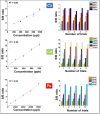Fabrication of a Low Cost Superhydrophobic Substrate for Surface Enhanced Laser-Induced Breakdown Spectroscopy and Its Utility through Identification of Electrolyte Variation for Oral Cancer Detection
- PMID: 38227930
- PMCID: PMC10865284
- DOI: 10.1021/acsbiomaterials.3c01275
Fabrication of a Low Cost Superhydrophobic Substrate for Surface Enhanced Laser-Induced Breakdown Spectroscopy and Its Utility through Identification of Electrolyte Variation for Oral Cancer Detection
Abstract
Ultratrace elemental detections from a limited volume of samples can offer significant benefits in biomedical fields. However, it can be challenging to concentrate the particles being analyzed in a small area to improve the accuracy of detection. Ring-like deposits on the edges of colloidal droplets are a vexing problem in many applications. Herein, we report ultratrace elemental detection using a superhydrophobic surface-enhanced laser-induced breakdown spectroscopy (SELIBS) substrate fabricated by laser ablation followed by a soft lithography technique. In this work, the SELIBS spectra on a superhydrophobic polydimethylsiloxane (PDMS) substrate replicated from a laser-patterned master Teflon substrate are investigated. This work highlights the application of this newly created superhydrophobic substrate for detecting trace elements in body fluids using SELIBS. The developed PDMS substrate was successfully adopted to investigate the electrolyte variation in serum samples of oral cancer patients and normal volunteers. Principal component analysis (PCA) and match-no-match analysis were used to distinguish the elemental variation in cancer and control groups.
Keywords: SELIBS; biomedical sensing; nanostructured material; oral cancer; superhydrophobic PDMS.
Conflict of interest statement
The authors declare no competing financial interest.
Figures







Similar articles
-
Low-adhesive superhydrophobic surface-enhanced Raman spectroscopy substrate fabricated by femtosecond laser ablation for ultratrace molecular detection.J Mater Chem B. 2017 Jan 28;5(4):777-784. doi: 10.1039/c6tb02629j. Epub 2017 Jan 5. J Mater Chem B. 2017. PMID: 32263846
-
Superhydrophobic candle soot/PDMS substrate for one-step enrichment and desalting of peptides in MALDI MS analysis.Talanta. 2018 Dec 1;190:23-29. doi: 10.1016/j.talanta.2018.07.066. Epub 2018 Jul 21. Talanta. 2018. PMID: 30172504
-
A large-scale superhydrophobic surface-enhanced Raman scattering (SERS) platform fabricated via capillary force lithography and assembly of Ag nanocubes for ultratrace molecular sensing.Phys Chem Chem Phys. 2014 Dec 28;16(48):26983-90. doi: 10.1039/c4cp03679d. Phys Chem Chem Phys. 2014. PMID: 25380327
-
Conventional and emerging strategies for the fabrication and functionalization of PDMS-based microfluidic devices.Lab Chip. 2021 Aug 21;21(16):3053-3075. doi: 10.1039/d1lc00288k. Epub 2021 Jul 21. Lab Chip. 2021. PMID: 34286800 Review.
-
Surface Modification Techniques for Endothelial Cell Seeding in PDMS Microfluidic Devices.Biosensors (Basel). 2020 Nov 19;10(11):182. doi: 10.3390/bios10110182. Biosensors (Basel). 2020. PMID: 33228050 Free PMC article. Review.
References
-
- Cremers D. A.; Multari R. A.; Knight A. K.; Meyers R. A. Laser-Induced Breakdown Spectroscopy. Encycl. Anal. Chem.: App. Theory Instrum. 2007, 1, 1–28. 10.1002/9780470027318.a5110t.pub3. - DOI
-
- Pathak A. K.; Kumar R.; Singh V. K.; Agrawal R.; Rai S.; Rai A. K. Assessment of LIBS for Spectrochemical Analysis: A Review. Appl. Spectrosc. Rev. 2012, 47, 14–40. 10.1080/05704928.2011.622327. - DOI
-
- Cao F.; Jiao F.; Ma S.; Dong D. Laser-Induced Breakdown Spectroscopy Mediated Amplification Sensor for Copper (II) Ions Detection Using Click Chemistry. Sens. Actuators, B 2022, 371, 13259410.1016/j.snb.2022.132594. - DOI
Publication types
MeSH terms
Substances
LinkOut - more resources
Full Text Sources
Medical
